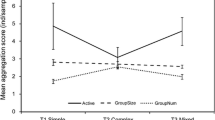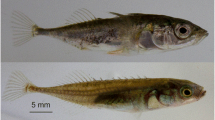Abstract
In contrast to the substantial number of theoretical papers that have examined the mechanisms by which cooperation may evolve, very few studies have investigated patterns of co-operation in natural animal populations. In the current study, we use a novel approach, social network analysis, to investigate the structure of co-operative interactions in the context of predator inspection in a wild population of guppies (Poecilia reticulata). Female guppies showed social preferences for stable partners, fulfilling a key assumption made by models of reciprocity. In the laboratory, wild female guppies disproportionately engaged in predator inspection with others with whom they had strong social associations. Furthermore, pairs of fish that frequently engaged in predator inspection did so in a particularly co-operative way, potentially reducing costs associated with predator inspection. Taken together, these results provide evidence for assortative interactions forming the basis of co-operation during predator inspection in a natural fish population. The occurrence of highly interconnected social networks between stable partners suggests the existence of co-operation networks in free-ranging populations of the guppy.


Similar content being viewed by others
References
Allee WC (1951) Cooperation among animals. Schuman, New York
Boesch C (1994) Cooperative hunting in wild chimpanzees. Anim Behav 48:653–667
Borgatti SP, Everett MG, Freeman LC (2002) Ucinet for Windows: Software for social network analysis. Analytic Technologies, Harvard
Croft DP, Albanese B, Arrowsmith BJ, Botham M, Webster M, Krause J (2003a) Sex biased movement in the guppy (Poecilia reticulata). Oecologia 137:62–68
Croft DP, Arrowsmith BJ, Bielby J, Skinner K, White E, Couzin ID, Magurran AE, Ramnarine I, Krause J (2003b) Mechanisms underlying shoal composition in the Trinidadian guppy (Poecilia reticulata). Oikos 100:429–438
Croft DP, Botham MS, Krause J (2004a) Is sexual segregation in the guppy, Poecilia reticulata, consistent with the predation risk hypothesis? Environ Biol Fisches 71:127–133
Croft DP, Krause J, James R (2004b) Social networks in the guppy (Poecilia reticulata). Proc R Soc Lond Biol Lett 271:516–519
Croft DP, James R, Ward AJW, Botham MS, Mawdsley D, Krause J (2005) Assortative interactions and social networks in fish. Oecologia 143:211–219
Crowley PH (1992) Resampling methods for computation-intensive data-analysis in ecology and evolution. Annu Rev Ecol Syst 23:405–477
Darwin C (1859) The origin of species. J. Murray, London
Dugatkin LA (1988) Do guppies play tit for tat during predator inspection visits. Behav Ecol Sociobiol 23:395–399
Dugatkin LA (1992) Tendency to inspect predators predicts mortality risk in the guppy (Poecilia reticulata). Behav Ecol 3:124–127
Dugatkin LA (1997) Cooperation among animals: an evolutionary perspective. Oxford University Press, Oxford
Dugatkin LA, Alfieri M (1991) Guppies and the tit-for-tat strategy — preference based on past interaction. Behav Ecol Sociobiol 28:243–246
Dugatkin LA, Godin JGJ (1992) Predator inspection, shoaling and foraging under predation hazard in the Trinidadian guppy, Poecilia reticulata. Environ Biol Fisches 34:265–276
Dugatkin LA, Wilson DS (2000) Assortative interactions and the evolution of cooperation during predator inspection in guppies (Poecilia reticulata). Evol Ecol Res 2:761–767
Gatewood JB (1984) Cooperation, competition, and synergy — information-sharing groups among southeast Alaskan salmon seiners. Am Ethnol 11:350–370
Griffiths SW (2003) Learned recognition of conspecifics by fishes. In: Fish are smarter than you think: learning in fishes, Brown C, Laland KN, Krause J (eds) Fish Fish 4:256–268 (special edition)
Griffiths SW, Magurran AE (1998) Sex and schooling behaviour in the Trinidadian guppy. Anim Behav 56:689–693
Haccou P, Meelis E (1992) Fisher’s omnibus test. In: Statistical analysis of behavioural data, an approach based on time-structured models, Oxford University Press, Oxford, pp 329–240
Hamilton WD (1963) Evolution of Altruistic Behavior. Am Nat 97:354–356
Hammerstein P (2002) Why is reciprocity so rare in social animals? A protestant appeal. In: Hammerstein P (ed) Genetic and cultural evolution of cooperation. Dahlem University Press, Berlin, pp83–93
Krause J, Ruxton GD, Rubenstein D (1998) Is there always an influence of shoal size on predator hunting success? J Fish Biol 52:494–501
Kropotkin P (1908) Mutual aid, 3rd edn. William Heinemann, London
Kulling D, Milinski M (1992) Size-dependent predation risk and partner quality in predator inspection of sticklebacks. Anim Behav 44:949–955
Long AG (2003) Defense pacts and international trade. J Peace Res 40:537–552
Magurran AE, Seghers BH (1994a) Predator inspection behaviour Covaries with schooling tendency amongst wild guppy, Poecilia reticulata, populations in Trinidad. Behaviour 128:121–134
Magurran AE, Seghers BH (1994b) Sexual conflict as a consequence of ecology — evidence from guppy, Poecilia reticulata, populations in Trinidad. Proc R Soc Lond Ser B Biol Sci 255:31–36
Magurran AE, Seghers BH, Shaw PW, Carvalho GR (1995) The behavioural diversity and evolution of guppy, Poecilia reticulata, populations in Trinidad. Adv Study Behav 24:155–202
Milinski M (1987) Tit-for-tat in sticklebacks and the evolution of cooperation. Nature 325:433–435
Milinski M, Külling D, Kettler R (1990a) Tit for tat: sticklebacks (Gasterosteus aculeatus) “trusting” a cooperating partner. Behav Ecol 1:7–11
Milinski M, Pfluger D, Külling D, Kettler R (1990b) Do sticklebacks cooperate repeatedly in reciprocal pairs? Behav Ecol Sociobiol 27:17–21
Milinski M, Luthi JH, Eggler R, Parker GA (1997) Cooperation under predation risk: experiments on costs and benefits. Proc R Soc Lond Ser B-Biol Sci 264:831–837
Newman MEJ (2003) The structure and function of complex networks. SIAM Rev 45:167–256
Pitcher TJ, Parrish JK (1993) Functions of shoaling behaviour in teleosts. In: Pitcher TJ (ed) Behaviour of Teleost Fishes, 2nd edn. Chapman & Hall, London, pp363–439
Pitcher TJ, Magurran AE, Allan JR (1983) Shifts of behaviour with shoal size in Cyprinids. In: Proceedings of the 3rd British Freshwater Fish Conference, pp220–228
Pitcher TJ, Green DA, Magurran AE (1986) Dicing with death — predator inspection behaviour in minnow shoals. J Fish Biol 28:439–448
Russell ST, Kelley JL, Graves JA, Magurran AE (2004) Kin structure and shoal composition dynamics in the guppy, Poecilia reticulata. Oikos 106:520–526
Seghers BH (1974) Schooling behaviour in the guppy (Poecilia reticulata): an evolutionary response to predation. Evolution 28:486–489
Trivers RL (1971) Evolution of reciprocal altruism. Q Rev Biol 46:35–57
Trivers R (2004) Mutual benefits at all levels of life. Science 304:964–965
Ward AJW, Hart PJB (2003) The effects of kin and familiarity on interactions between fish. Fish Fish 4:348–358
Ward AJW, Botham MS, Hoare DJ, James R, Broom M, Godin JGJ, Krause J (2002) Association patterns and shoal fidelity in the three-spined stickleback. Proc R Soc Lond Ser B-Biol Sci 269:2451–2455
Wilkinson GS (1984) Reciprocal food sharing in the vampire bat. Nature 308:181–184
Wilson DS (1975) Theory of group selection. Proc Natl Acad Sci U S A 72:143–146
Wilson DS, Dugatkin LA (1997) Group selection and assortative interactions. Am Nat 149:336–351
Acknowledgements
DPC would like to acknowledge funding from the Leverhulme Trust and the FSBI. We would also like to thank Ronnie Hernandez and the Board of Asa Wright Nature Centre, for their continued support in Triniwdad, Jenny James and Marc Botham for assistance in the field, Manfred Milinski, Jean-Guy Godin and Iain Couzin for insightful discussion and comments.
Author information
Authors and Affiliations
Corresponding author
Additional information
Communicated by K. Lindström
Rights and permissions
About this article
Cite this article
Croft, D.P., James, R., Thomas, P.O.R. et al. Social structure and co-operative interactions in a wild population of guppies (Poecilia reticulata). Behav Ecol Sociobiol 59, 644–650 (2006). https://doi.org/10.1007/s00265-005-0091-y
Received:
Revised:
Accepted:
Published:
Issue Date:
DOI: https://doi.org/10.1007/s00265-005-0091-y




